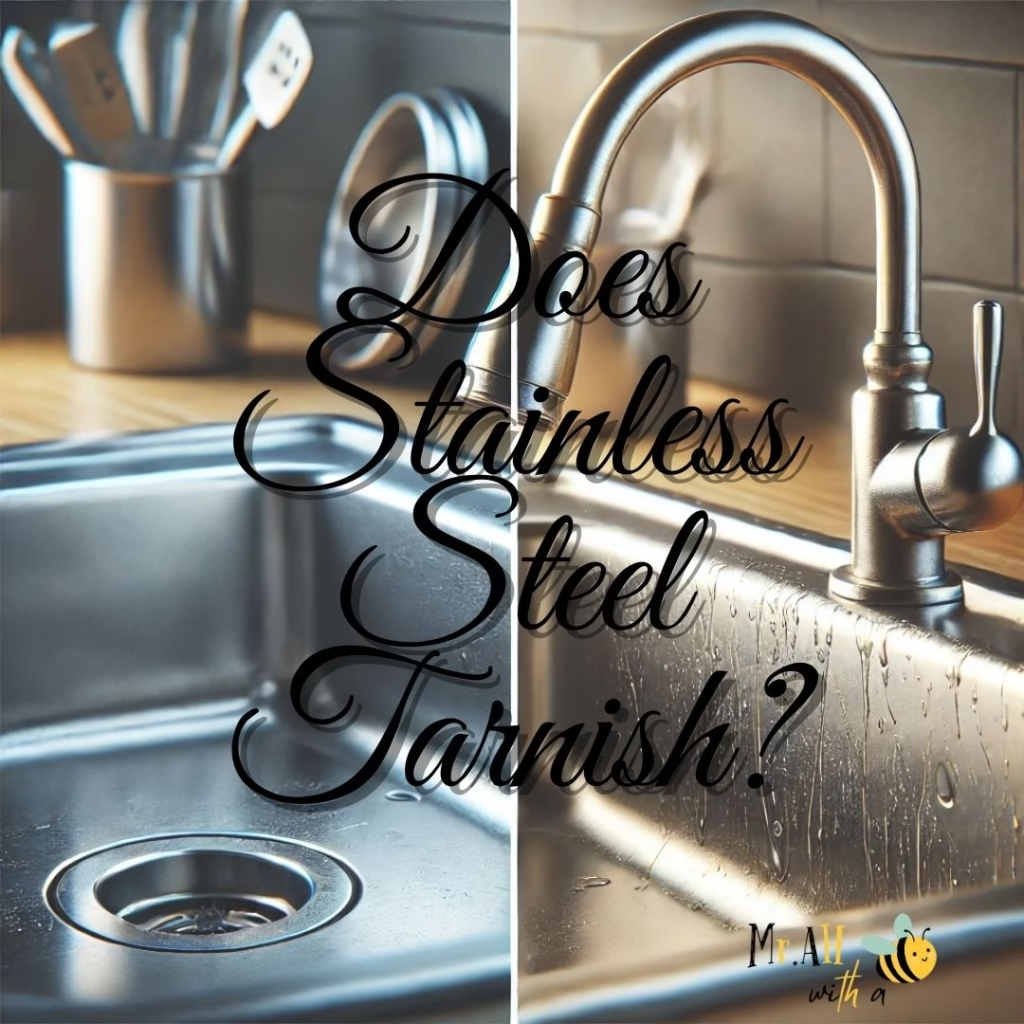Does stainless steel tarnish? This is a commonly asked question by people who use stainless steel in kitchens, jewelry, construction, and medical tools. Stainless steel is widely popular for its durability, resistance to corrosion, and sleek appearance. However, concerns about tarnishing often arise because of its frequent use in various environments. This blog will explore whether stainless steel tarnishes, under what conditions it might happen, and how you can care for it to keep it looking its best.
Understanding Stainless Steel
Composition of Stainless Steel
Stainless steel is an alloy primarily made of iron, with key elements like chromium, nickel, and sometimes molybdenum. The key to its durability is the inclusion of at least 10.5% chromium, which reacts with oxygen to form a thin, invisible passive oxide layer. This layer protects the steel from corrosion, rust, and tarnishing.
Different Grades of Stainless Steel:
- 304 Stainless Steel: It is the most common grade, known for its excellent corrosion resistance and versatility. It is widely used in kitchenware, appliances, and food processing equipment due to its durability and ease of cleaning.
- 316 Stainless Steel: 316 stainless steel contains molybdenum, which enhances its resistance to chlorides and other corrosive elements. This makes it an ideal choice for marine environments, medical applications, and chemical processing where superior durability is required.
- 430 Stainless Steel: This grade of stainless steel is less resistant to corrosion compared to other grades but is widely used for decorative applications. Its attractive finish and lower cost make it popular in household items, automotive trim, and appliances where aesthetic appeal is important.
Corrosion Resistance
The passive oxide layer is the key to stainless steel’s resistance to tarnish and rust. This thin, protective film forms naturally when chromium reacts with oxygen, preventing further corrosion and allowing the metal to maintain its luster. This makes stainless steel an ideal choice for a variety of applications, including kitchen appliances and medical equipment.
However, environmental factors and improper care can damage this layer, leading to tarnishing. Exposure to harsh chemicals, high humidity, or salt can compromise its effectiveness, while abrasive cleaning methods can scratch the surface, allowing moisture to penetrate.
What is Tarnishing?
Definition of Tarnishing
Tarnishing is the process where a thin, dull layer forms on the surface of a metal due to chemical reactions with environmental elements such as oxygen, sulfur, or salt. Often manifesting as a gray, yellow, or greenish tint, this layer can vary in color, depending on the metal involved and the specific chemicals it encounters. Unlike rusting, which primarily affects iron and results in flaky red-brown oxidation, tarnish appears as a discoloration or dull sheen, indicating a surface reaction rather than structural damage. While tarnishing does not compromise the integrity of the metal itself, it can affect its aesthetic appeal and, in some cases, its performance. Regular maintenance and proper care can help prevent tarnishing and keep metals looking their best.
Common Materials That Tarnish
Metals like silver, brass, and copper are particularly prone to tarnishing due to their reactivity with environmental elements. Silver tarnishes when exposed to sulfur compounds in the air, forming a dark layer of silver sulfide. Copper can develop a greenish patina known as verdigris over time, while brass—an alloy of copper and zinc—can acquire a dull patina due to oxidation and exposure to moisture.
Factors That Cause Tarnishing
- Humidity and Moisture: Prolonged exposure to damp conditions can compromise the passive oxide layer on stainless steel, making it more vulnerable to corrosion. High humidity levels can create an environment conducive to moisture accumulation, which can lead to tarnishing and surface degradation over time.
- Saltwater: Chlorides found in saltwater can cause significant damage to stainless steel, particularly lower grades that lack enhanced corrosion resistance. This exposure may lead to pitting, a form of localized corrosion that creates small holes in the surface, compromising the overall integrity of the metal.
- Air Pollutants: Industrial areas with high levels of air pollutants, particularly sulfur-containing gases, can contribute to surface staining on stainless steel. These pollutants react with the metal, leading to discoloration and tarnishing that can be difficult to remove without proper cleaning.
- Chemical Cleaners: Harsh cleaning agents, especially those containing bleach or ammonia, can erode the protective oxide layer on stainless steel. This erosion not only increases the risk of tarnishing but also diminishes the metal’s resistance to environmental factors, making it more susceptible to corrosion.
Does Stainless Steel Tarnish?
Conditions Leading to Tarnishing
While stainless steel is highly resistant to tarnish, certain conditions can compromise its protective layer:
- Exposure to Chlorides: Saltwater or chlorinated environments can significantly affect grades like 304 stainless steel, leading to increased susceptibility to corrosion. The presence of chlorides can initiate pitting and crevice corrosion, which compromise the integrity and appearance of the metal over time.
- Harsh Chemicals: Contact with bleach or acidic cleaners can severely damage the protective oxide layer of stainless steel. This damage not only promotes tarnishing but also increases the risk of corrosion, as the metal becomes more exposed to environmental elements.
- High Heat and Prolonged Use: Excessive heat can cause discoloration in stainless steel, particularly in cookware or industrial settings where high temperatures are common. This heat-induced discoloration can detract from the aesthetic appeal of the metal and may also indicate underlying changes in its properties, affecting performance.
Differences in Tarnishing Among Grades
304 Stainless Steel
304 stainless steel is more susceptible to tarnishing, particularly when exposed to chlorides found in saltwater or marine environments. This vulnerability can lead to pitting and surface discoloration, making it less ideal for applications in coastal or high-humidity areas.
316 Stainless Steel
316 stainless steel offers better resistance to tarnish, even in challenging marine environments, thanks to its molybdenum content. This added element enhances its corrosion resistance, making it the preferred choice for applications in saltwater and other corrosive settings, ensuring durability and longevity.
Common Misconceptions
Stainless Steel Cannot Tarnish
Many people believe that stainless steel is immune to tarnishing. While it is significantly more resistant to tarnish than other metals, “stainless” does not mean “stain-proof.” Environmental factors and improper care can still lead to tarnishing under certain conditions.
Stainless Steel is Completely Corrosion-Resistant
A common misconception is that all stainless steel grades are equally resistant to corrosion. In reality, different grades have varying levels of corrosion resistance, with some being more susceptible to tarnishing or corrosion in harsh environments, such as those containing chlorides.
Surface Stains Are the Same as Tarnishing
Surface stains caused by water spots, oil build-up, or food residues are often confused with tarnishing. While these stains can affect the appearance of stainless steel, they do not indicate damage to the oxide layer and can usually be cleaned off easily.
Tarnishing Is Permanent
Some believe that once stainless steel tarnishes, it is permanently damaged. However, tarnishing can often be removed with proper cleaning methods, restoring the metal’s original luster and appearance.
All Stainless Steel Requires the Same Maintenance
There’s a misconception that all stainless steel items require the same level of care. In fact, different grades and uses may necessitate specific maintenance practices to prevent tarnishing and ensure longevity.
Maintenance and Care
Preventing Tarnishing
Clean Regularly
To keep stainless steel free of tarnish, it’s essential to clean surfaces regularly using mild soap and water. After cleaning, dry the surface with a soft cloth to prevent water spots and maintain the metal’s luster.
Avoid Harsh Chemicals
Avoid using harsh chemicals such as bleach, abrasive cleaners, or acidic solutions, as these can damage the protective oxide layer. Instead, opt for gentle cleaning products specifically designed for stainless steel to ensure the integrity of the surface is preserved.
Protect Against Salt
If stainless steel items are exposed to saltwater, it’s crucial to rinse them promptly with fresh water to remove any corrosive salt residues. This simple step helps prevent pitting and tarnishing, especially in marine environments.
Polish Periodically
To restore shine and enhance the appearance of stainless steel, use stainless steel cleaners or polishes periodically. These products not only remove tarnishes and stains but also help reinforce the protective oxide layer, ensuring long-lasting durability.
Restoring Tarnished Stainless Steel
If tarnishing occurs, follow these methods to restore the surface:
DIY Solutions
Mixing baking soda and water into a paste creates an effective and gentle cleaner for stainless steel. Rub the paste gently with a microfiber cloth to remove the tarnish and stains without scratching the surface.
Vinegar Solution
A diluted vinegar solution serves as a natural remedy for light discoloration on stainless steel surfaces. Wiping with this solution not only helps to eliminate stains but also leaves a streak-free finish, enhancing the metal’s shine.
Commercial Cleaners
Using stainless steel polishes or tarnish removers specifically designed for stainless steel can provide a more thorough cleaning. These products contain formulations that effectively lift tarnish and restore the metal’s original luster while protecting the surface from future damage.
Tip: Always clean in the direction of the steel’s grain to avoid scratches.
Conclusion
In summary, does stainless steel tarnish? While stainless steel is renowned for its durability and resistance to corrosion, it is not completely immune to tarnishing. Factors such as environmental exposure, harsh chemicals, and improper care can compromise its protective oxide layer, leading to discoloration. Understanding the characteristics of different stainless steel grades and maintaining proper care can help prevent tarnishing and keep your stainless steel items looking their best. By following recommended cleaning practices and using appropriate restoration methods, you can ensure the longevity and aesthetic appeal of your stainless steel products.
FAQs
1. Does stainless steel tarnish easily?
No, stainless steel is highly resistant to tarnishing, but exposure to harsh conditions can cause discoloration.
2. What causes stainless steel to tarnish?
Factors like saltwater, harsh chemicals, and high humidity can damage its protective oxide layer.
3. How can I clean tarnished stainless steel?
Use a mixture of baking soda and water, diluted vinegar, or commercial stainless steel polish.
4. Does 304 stainless steel tarnish?
Yes, 304 stainless steel can tarnish when exposed to chlorides like saltwater.
5. Does stainless steel jewelry tarnish?
Stainless steel jewelry is highly resistant to tarnishing but may discolor with prolonged exposure to sweat, oils, or chemicals.
6. How can I prevent stainless steel from tarnishing?
Clean regularly, avoid harsh chemicals, and rinse items exposed to salt or pollutants.
7. Is tarnishing the same as rusting?
No, tarnishing is surface discoloration, while rusting is a deeper oxidation process causing corrosion.
8. Which stainless steel grade resists tarnish best?
316 stainless steel offers the best resistance to tarnishing, even in harsh environments.
9. Can heat cause stainless steel to tarnish?
Yes, excessive heat can cause discoloration, especially in cookware or industrial tools.
10. Is tarnishing permanent on stainless steel?
No, tarnish can be removed with proper cleaning techniques or commercial products.
For more articles related to DIY, click the link below




Thank you for reading, for more interesting articles visit our homepage.



